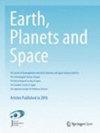针对太阳系天体空间风化优化的等离子体辐照系统
IF 2.5
3区 地球科学
引用次数: 0
摘要
摘要在太阳系脆弱的大气天体中,天体表面的空间风化是天体演化时间尺度上天体表面物理化学演化和环境演化的重要过程。空间等离子体是空间风化的主要能量和物质来源。实验室等离子体辐照实验是模拟空间等离子体驱动的空间风化的有效方法。然而,由于早期设施的能力没有针对真实的空间风化进行优化,因此尚未进行等离子体空间风化的全面建模;例如,入射的电子和离子不是在相同的条件下辐照的。在此,我们开发了一个等离子体辐照系统——天体环境等离子体辐照仿真器(PIECE),该系统在相同条件下通过电子和离子辐照,再现了稀薄大气体中等离子体的空间风化。我们成功地开发了一个系统,在1- 30 keV范围内的任何加速能量下,电子和离子数通量为$$\sim 10^{13} - 10^{16} {\text{ particles cm}}^{{ - {2}}} {\text{s}}^{{ - {1}}}$$ ~ 10 13 - 10 16个粒子cm - 2s - 1,辐照时间为1天,其通量为$$\sim 10^{18} - 10^{21} {\text{ particles cm}}^{{ - {2}}} {\text{s}}^{{ - {1}}}$$ ~ 10 18 - 10 21个粒子cm - 2s - 1。这相当于欧罗巴上的等离子体辐照时间为103 - 106年。图形摘要本文章由计算机程序翻译,如有差异,请以英文原文为准。
A plasma irradiation system optimized for space weathering of solar system bodies
Abstract In the tenuous atmospheric bodies of our solar system, space weathering on the celestial surface is an important process for its chemical and physical evolution and ambient environment on timescales of celestial evolution. Space plasma is a dominant energy and material source for space weathering. Plasma irradiation experiment in the laboratory is an effective method for modeling space weathering driven by space plasma. However, comprehensive modeling of plasma space weathering has not yet been conducted because the capabilities of the earlier facilities were not optimized for realistic space weathering; for example, the incident electron and ion were not irradiated in the same condition. Here, we developed a plasma irradiation system, Plasma Irradiation Emulator for Celestial Environments (PIECE) of the solar system bodies, which reproduces plasma space weathering in tenuous atmospheric bodies by the electron and ion irradiations in the same condition. We successfully developed a system with high electron and ion number fluxes of $$\sim 10^{13} - 10^{16} {\text{ particles cm}}^{{ - {2}}} {\text{s}}^{{ - {1}}}$$ ∼ 10 13 - 10 16 particles cm - 2 s - 1 at any acceleration energy in the range of 1–30 keV, which leads to a fluence of e.g., $$\sim 10^{18} - 10^{21} {\text{ particles cm}}^{{ - {2}}} {\text{s}}^{{ - {1}}}$$ ∼ 10 18 - 10 21 particles cm - 2 s - 1 , with a 1-day irradiation time. This fluence corresponds to a plasma irradiation time of ~ 10 3 –10 6 years on Europa. Graphical Abstract
求助全文
通过发布文献求助,成功后即可免费获取论文全文。
去求助
来源期刊

Earth, Planets and Space
地学天文-地球科学综合
CiteScore
5.80
自引率
16.70%
发文量
167
期刊介绍:
Earth, Planets and Space (EPS) covers scientific articles in Earth and Planetary Sciences, particularly geomagnetism, aeronomy, space science, seismology, volcanology, geodesy, and planetary science. EPS also welcomes articles in new and interdisciplinary subjects, including instrumentations. Only new and original contents will be accepted for publication.
 求助内容:
求助内容: 应助结果提醒方式:
应助结果提醒方式:


